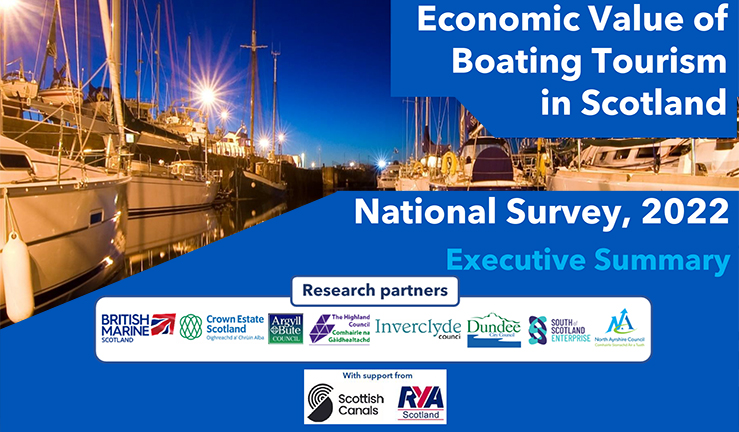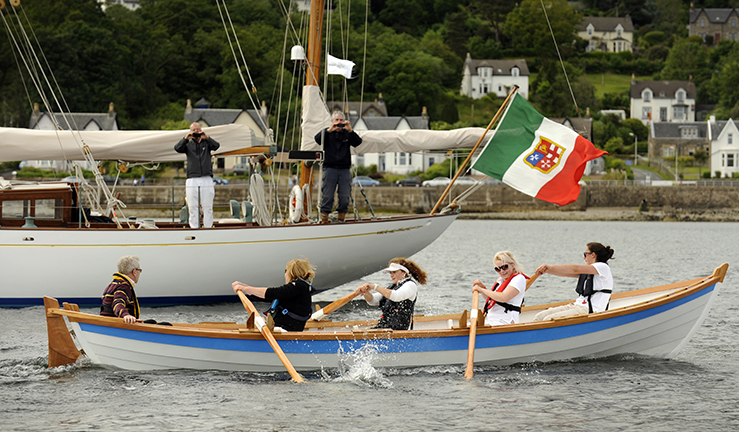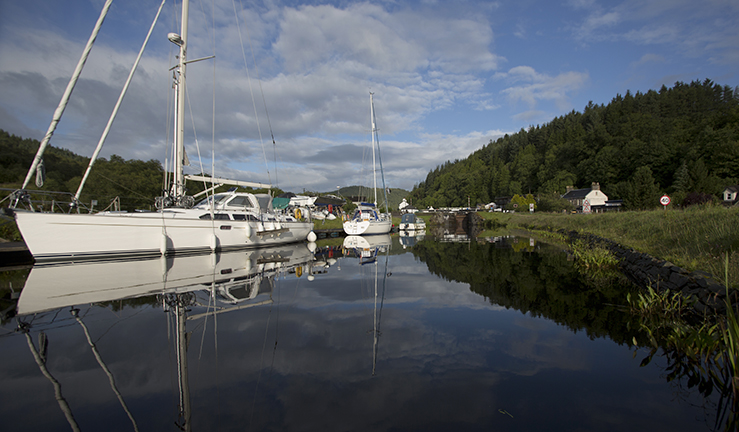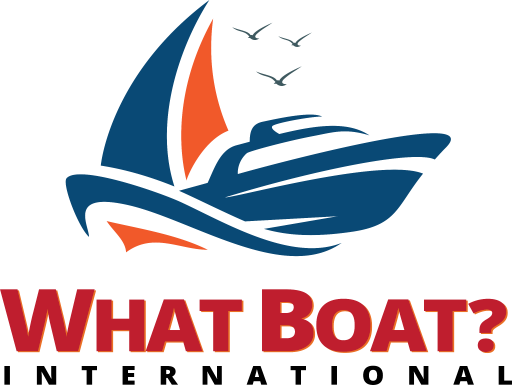
According to the Economic Value of Boating Tourism in Scotland Survey 2022, sailing /boating is estimated to contribute £84m in Gross Value Added (GVA) and 3,100 Full Time Equivalent (FTE) jobs – many in rural and fragile coastal communities.
Prepared by EKOS on behalf of British Marine Scotland, RYA Scotland, Scottish Canals, Crown Estate Scotland, South of Scotland Enterprise Agency and the local authorities of North Ayrshire, Argyll and Bute, Dundee, Highland, and Inverclyde, the study, which is undertaken every 6/7 years (2009, 2016, 2022), provides vital evidence on how the boating/sailing tourism sector is performing in Scotland. It ensures that the industry, as well as partners/stakeholders, has quality, robust data on recent performance with a forward-looking view to identify challenges and opportunities.

Martin Latimer, Joint Chairman of British Marine Scotland commented: “This report highlights very positive statistics for the leisure marine sector in Scotland. The Boating Tourism sector continues to perform very well and this report emphasises the value of the sector for employment and revenue generation but also to wider agendas like health and wellbeing. Marine tourism is an essential contributor to our coastal economies and communities and the fact that current marine tourism applications under Growth Deal and Levelling Up Funds accounts for in excess of £68m shows the importance of the sector to the Scottish Economy and Local Authorities. British Marine Scotland will continue to work with our partners and particularly local authorities, RYA Scotland and Scottish Canals to strengthen the sector even further and to provide more jobs and training to support development and delivery.”
Responses were provided from boaters and leisure cruisers, operators, charter organisations and strategic stakeholders, with key findings from the report showing:
- Since 2016 the sector continues to demonstrate a strong fit with national and regional policy, including the National Performance Framework (NPF) and National Strategy for Economic Transformation (NSET).
- There is now a greater recognition and an evidence base that the sectors’ contribution is more than just the economic value that it generates – but includes wider cross-cutting policy priorities such as net zero and wellbeing.
- Berthing capacity has increased by 1,100 berths since 2016 with demand in Scotland remaining buoyant, with the total capacity now 16,800 berths. Areas with previously less developed infrastructure offer such as the East Region have experienced the largest growth and there is also a strong pipeline across Scotland of planned development activity – increasing capacity by a further 1,280 berths by 2030.
- In 2022, sailing/boating is estimated to contribute £84m in Gross Value Added (GVA) and 3,100 Full Time Equivalent (FTE) jobs – many in rural and fragile coastal communities.
- The survey shows despite unprecedented challenges including Brexit and Covid-19 pandemic the sector has shown resilience and since 2016 has experienced real-term growth in GVA of plus 8% compared to a contraction of -1.1% across the overall Scottish economy.
- In terms of future growth projections, based on 17 pipeline development projects that would enhance the overall berthing capacity in Scotland by 1,280 (plus 8%), GVA could increase to £90m-£92m per year, and support 3,250-3,340 FTE jobs (an uplift of between 150-240 FTE jobs).
- The study also identified over the medium term, much of Scotland’s berthing and shoreside infrastructure assets will be 30 plus years old, and in line with Scottish Government/Scottish Future Trust Infrastructure Investment Plan for Scotland 2021/22 to 2025/26 the focus will be on maximising the useful life of existing assets through maintenance, repair, and upgrades.
- Feedback identified that while the overall offer in Scotland was felt to be good, in comparison to other destinations (particularly in mainland Europe and Scandinavia); customer service, the age/quality of shoreside and onshore infrastructure and range of facilities, such as nearby accommodation/restaurants were felt to be inconsistent.
- Access to capital funding and investment will therefore be important to help ensure Scotland can deliver a consistent and good quality service offering.
- Opportunities were also identified for growth and development within the staycation market, integrating a mixed sport and activity offering, and enhancing the green credentials of the sector all offer opportunities to grow.

Looking to the future, the study also found that there are opportunities to reframe the lens by which the sector considers future development opportunities:
- Sport first – integration with other rapidly growing areas of water-based tourism – SUPs, kayaks, coastal rowing.
- Community first – locally-led activity where revenues can be reinvested by, and for the betterment of the local community.
- Region first – driving regional change through economies of scale and positive spillovers.
Richard Millar, Interim CEO, Scottish Canals, which manages and cares for over 140-miles of inland waterways across the county and are one of the key strategic stakeholder consultees who contributed to the research commented: “It is clear from the survey’s findings that Scottish Canals play a significant part in contributing to Scotland’s boating tourism economy. As custodians of Scotland’s 250-year-old inland waterways we will continue to look at every which way we can to grow as we continue to invest and maintain our assets to look forward to another 250 years.”

While James Stuart, Strategic Lead for Giant Strides, the Scottish Marine Tourism Strategy, said: “This study underlines how significant the contribution of Marine Tourism is to Scotland and especially to remote and rural locations. Importantly, the growth contributes to much more than the economy, driving benefits to communities and the environment. The report also highlights key areas of focus for the coming years, taking the fantastic examples of sport-first, community-first and region-first development and sharing them round the rest of Scotland.”
Brian Wilson, Chair of the Royal Yachting Association (RYA) Scotland, the Scottish governing body for sailing, dinghy sailing, yacht and motor cruising, sail racing, RIBs and sportsboats, windsurfing and personal watercraft and a leading representative for inland waterways cruising, added: “The sports we support contribute to rural economies, build communities and provide quality jobs. I’m very pleased to see this recognised in the study and the specific focus on the community watersports – sport-first – work we are already supporting. These models, centered round a set of sporting activities, knit communities together, support skills development and add to the rural economy. An approach that is relevant right across Scotland.”
Lesley Robinson, CEO, British Marine concluded: “This report demonstrates some very positive and promising statistics for the leisure boating sector in Scotland. It shows that despite the challenges we all faced through the pandemic, the sector has remained buoyant and appears to be flourishing.
“With continued investment from the forthcoming Growth Deals and Levelling Up Funds we would expect to see continued growth and development of the marine sector and contributions into stronger communities in Scotland.”
Significant engagement, consultation and survey work was undertaken over a four-month period to gather the relevant data and qualitative insights to feed into the study. To read the full report visit https://mymembership.britishmarine.co.uk/resources/publications/posts/2023-8/march/measuring-the-economic-value-of-boating-tourism-in-scotland/
Other useful information
New Strategy to Boost Scotland’s Marine Tourism: Giant Strides, 2020-2025 – https://britishmarine.co.uk/News/2020/March/New-Strategy-to-Boost-Scotlands-Marine-Tourism-Giant-Strides-2020-025
Careers in Scotland videos – https://mymembership.britishmarine.co.uk/careers-and-training/scotland/careers-in-scotland-videos/

